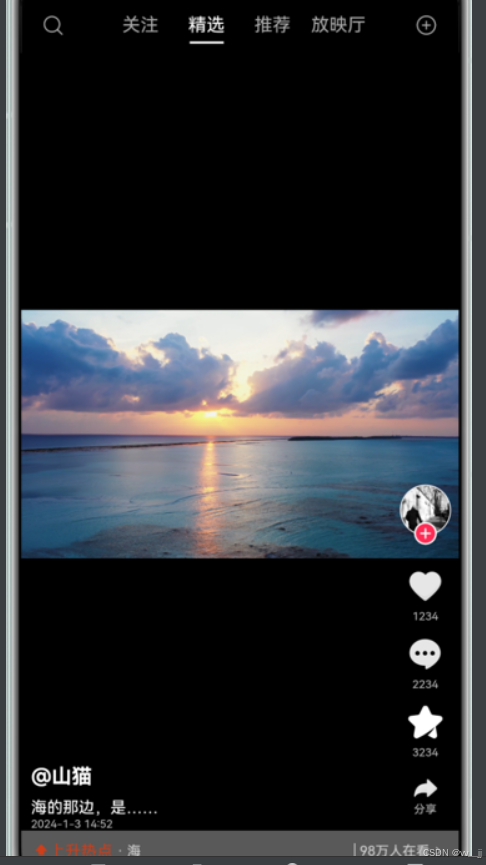短视频切换
简介
本示例基于Swiper组件实现了短视频的滑动上下切换。
效果预览

使用说明:
1.启动应用后显示短视频界面。
2.上下滑动切换短视频。
工程目录
├──entry/src/main/ets │ ├──common │ │ └──CommonConstants.ets // 常量类 │ ├──entryability │ │ └──EntryAbility.ets // 程序入口 │ ├──model │ │ ├──BasicDataSource.ets // 懒加载DataSource │ │ └──DataModel.ets // 数据类 │ ├──pages │ │ └──Index.ets // 首页 │ └──view │ ├──Side.ets // 视频信息 │ └──VideoSwiper.ets // 视频滑动组件 └──entry/src/main/resources // 应用资源目录
相关权限
不涉及
约束与限制
1.本示例仅支持标准系统上运行,支持设备:华为手机。
2.HarmonyOS系统:HarmonyOS NEXT Developer Beta1及以上。
3.DevEco Studio版本:DevEco Studio NEXT Developer Beta1及以上。
4.HarmonyOS SDK版本:HarmonyOS NEXT Developer Beta1 SDK及以上。
具体实现介绍
常量类
export class CommonConstants {
/**
* Full size.
*/
static readonly FULL_SIZE: string = '100%';
/**
* List item width.
*/
static readonly LIST_ITEM_WIDTH: string = '30%';
/**
* List width.
*/
static readonly LIST_WIDTH: string = '60%';
/**
* Column width.
*/
static readonly COLUMN_WIDTH: string = '60%';
/**
* Video information width.
*/
static readonly VIDEO_INFO_WIDTH: string = '80%';
/**
* Text width.
*/
static readonly TEXT_WIDTH: string = '70%';
/**
* Column height.
*/
static readonly COLUMN_HEIGHT: string = '70%';
/**
* Row width.
*/
static readonly ROW_WIDTH: string = '66%';
/**
* Duration
*/
static readonly DURATION: number = 200;
}
-
FULL_SIZE: 表示全尺寸,其值为字符串'100%'。用于设置元素的宽度或高度为容器的100%。 -
LIST_ITEM_WIDTH: 表示列表项的宽度,其值为字符串'30%'。用于设置列表中每个项的宽度。 -
LIST_WIDTH: 表示列表的宽度,其值为字符串'60%'。用于设置整个列表组件的宽度。 -
COLUMN_WIDTH: 表示列的宽度,其值为字符串'60%'。用于设置表格或布局中的列宽。 -
VIDEO_INFO_WIDTH: 表示视频信息的宽度,其值为字符串'80%'。用于设置视频信息组件的宽度。 -
TEXT_WIDTH: 表示文本的宽度,其值为字符串'70%'。用于设置文本内容的宽度。 -
COLUMN_HEIGHT: 表示列的高度,其值为字符串'70%'。用于设置表格或布局中的列高。 -
ROW_WIDTH: 表示行的宽度,其值为字符串'66%'。用于设置表格或布局中的行宽。 -
DURATION: 表示持续时间,其值为数字200。这个值是以毫秒为单位的时间长度,用于动画、过渡或其他需要持续时间的场景。
这些常量被声明为 static readonly,它们是静态的,不能被修改,并且只能在类外部通过类名来访问,例如 CommonConstants.FULL_SIZE。通过这样设计来确保这些值在应用程序的整个生命周期中保持不变,并且可以在不同的组件或模块之间共享。
程序入口
import { AbilityConstant, UIAbility, Want } from '@kit.AbilityKit';
import { hilog } from '@kit.PerformanceAnalysisKit';
import { window } from '@kit.ArkUI';
export default class EntryAbility extends UIAbility {
onCreate(want: Want, launchParam: AbilityConstant.LaunchParam): void {
hilog.info(0x0000, 'testTag', '%{public}s', 'Ability onCreate');
}
onDestroy(): void {
hilog.info(0x0000, 'testTag', '%{public}s', 'Ability onDestroy');
}
onWindowStageCreate(windowStage: window.WindowStage): void {
// Main window is created, set main page for this ability
hilog.info(0x0000, 'testTag', '%{public}s', 'Ability onWindowStageCreate');
windowStage.loadContent('pages/Index', (err) => {
if (err.code) {
hilog.error(0x0000, 'testTag', 'Failed to load the content. Cause: %{public}s', JSON.stringify(err) ?? '');
return;
}
hilog.info(0x0000, 'testTag', 'Succeeded in loading the content.');
});
}
onWindowStageDestroy(): void {
// Main window is destroyed, release UI related resources
hilog.info(0x0000, 'testTag', '%{public}s', 'Ability onWindowStageDestroy');
}
onForeground(): void {
// Ability has brought to foreground
hilog.info(0x0000, 'testTag', '%{public}s', 'Ability onForeground');
}
onBackground(): void {
// Ability has back to background
hilog.info(0x0000, 'testTag', '%{public}s', 'Ability onBackground');
}
}
使用TypeScript编写的类 EntryAbility,它继承自 UIAbility 类。
-
onCreate(want: Want, launchParam: AbilityConstant.LaunchParam): void:- 这个方法在
EntryAbility实例被创建时调用。 - 它接收两个参数:
want和launchParam,这些参数可能包含了启动这个ability(能力)时传递的信息和参数。 - 方法内部使用
hilog.info记录了一条信息日志,表明onCreate方法被调用。
- 这个方法在
-
onDestroy(): void:- 这个方法在
EntryAbility实例被销毁时调用。 - 它记录了一条信息日志,表明
onDestroy方法被调用。
- 这个方法在
-
onWindowStageCreate(windowStage: window.WindowStage): void:- 这个方法在主窗口阶段(
windowStage)被创建时调用。 - 它记录了一条信息日志,表明
onWindowStageCreate方法被调用。 - 方法内部调用
windowStage.loadContent方法来加载页面内容,这里加载的是'pages/Index'。如果加载失败,它会记录一条错误日志。
- 这个方法在主窗口阶段(
-
onWindowStageDestroy(): void:- 这个方法在主窗口阶段被销毁时调用。
- 它记录了一条信息日志,表明
onWindowStageDestroy方法被调用。 - 这里可以释放与UI相关的资源。
-
onForeground(): void:- 这个方法在
EntryAbility被带到前台时调用。 - 它记录了一条信息日志,表明
onForeground方法被调用。
- 这个方法在
-
onBackground(): void:- 这个方法在
EntryAbility回到后台时调用。 - 它记录了一条信息日志,表明
onBackground方法被调用。
- 这个方法在
这个类处理了UI生命周期的不同阶段,包括创建、销毁、前台和后台切换,以及窗口阶段的创建和销毁。每个方法都使用 hilog 来记录日志。windowStage.loadContent 方法用于加载UI页面,这是UI框架中常见的模式,用于动态加载和显示页面内容。
懒加载
import { hilog } from '@kit.PerformanceAnalysisKit';
/**
* Basic implementation of data listening with IDataSource.
*/
export abstract class BasicDataSource implements IDataSource {
private listeners: DataChangeListener[] = [];
// Get the length of the array.
public abstract totalCount(): number;
// Retrieve data at the specified index.
public getData(index: number): void {
hilog.info(0x0000, 'testTag', 'getData, index:' + index);
}
// Add a listener to the data source for the LazyForEach component.
registerDataChangeListener(listener: DataChangeListener): void {
if (this.listeners.indexOf(listener) < 0) {
this.listeners.push(listener);
}
}
// Remove the listener from the data source for the corresponding LazyForEach component.
unregisterDataChangeListener(listener: DataChangeListener): void {
const pos = this.listeners.indexOf(listener);
if (pos >= 0) {
this.listeners.splice(pos, 1);
}
}
// Notify the LazyForEach component to reload all its child components.
notifyDataReload(): void {
this.listeners.forEach((listener: DataChangeListener) => {
listener.onDataReloaded();
});
}
// Notify the LazyForEach component to add a child component at the index corresponding to the specified index.
notifyDataAdd(index: number): void {
this.listeners.forEach((listener: DataChangeListener) => {
listener.onDataAdd(index);
})
}
// Notify the LazyForEach component that there is a change in the data at the index corresponding to the specified
// index, and that the child component at this index needs to be rebuilt.
notifyDataChange(index: number): void {
this.listeners.forEach((listener: DataChangeListener) => {
listener.onDataChange(index);
})
}
// Notify the LazyForEach component to remove the child component at the index corresponding to the specified index.
notifyDataDelete(index: number): void {
this





 最低0.47元/天 解锁文章
最低0.47元/天 解锁文章

















 2553
2553










